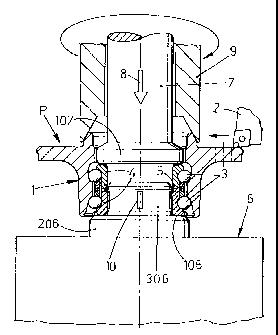Some of the information on this Web page has been provided by external sources. The Government of Canada is not responsible for the accuracy, reliability or currency of the information supplied by external sources. Users wishing to rely upon this information should consult directly with the source of the information. Content provided by external sources is not subject to official languages, privacy and accessibility requirements.
Any discrepancies in the text and image of the Claims and Abstract are due to differing posting times. Text of the Claims and Abstract are posted:
| (12) Patent: | (11) CA 2477137 |
|---|---|
| (54) English Title: | APPARATUS FOR MACHINING A HUB BEARING UNIT FOR A WHEEL OF A MOTOR VEHICLE |
| (54) French Title: | APPAREIL D'USINAGE D'UNE UNITE DE ROULEMENTS DE MOYEU DESTINEE A UNE ROUE D'UN VEHICULE A MOTEUR |
| Status: | Expired and beyond the Period of Reversal |
| (51) International Patent Classification (IPC): |
|
|---|---|
| (72) Inventors : |
|
| (73) Owners : |
|
| (71) Applicants : |
|
| (74) Agent: | MARKS & CLERK |
| (74) Associate agent: | |
| (45) Issued: | 2010-05-11 |
| (86) PCT Filing Date: | 2003-06-20 |
| (87) Open to Public Inspection: | 2004-01-08 |
| Examination requested: | 2008-04-01 |
| Availability of licence: | N/A |
| Dedicated to the Public: | N/A |
| (25) Language of filing: | English |
| Patent Cooperation Treaty (PCT): | Yes |
|---|---|
| (86) PCT Filing Number: | PCT/EP2003/006554 |
| (87) International Publication Number: | EP2003006554 |
| (85) National Entry: | 2004-08-20 |
| (30) Application Priority Data: | ||||||
|---|---|---|---|---|---|---|
|
The presser (7, 107) for the axial pre-loading of the internal crowns (4) of
the bearings, is co-axially inserted in the driver (9), with possibility of
relative movement with respect to the same driver. The internal crown of the
bearing which is resting on the flat reference surface (106) co-operates with
a centring pin (306) which may be provided with movable and active members
(10) useful for the same centring.
L'invention concerne une presseuse (7, 107) destinée au pré-chargement axial des couronnes internes (4) des roulements et étant introduite de manière coaxiale dans l'entraînement (9), un déplacement relatif par rapport à l'entraînement étant possible. La couronne interne du roulement reposant sur la surface de référence plate (106) coopère avec une broche centrale (306) pouvant être équipée d'éléments mobiles et actifs (10) utiles pour le centrage.
Note: Claims are shown in the official language in which they were submitted.
Note: Descriptions are shown in the official language in which they were submitted.

2024-08-01:As part of the Next Generation Patents (NGP) transition, the Canadian Patents Database (CPD) now contains a more detailed Event History, which replicates the Event Log of our new back-office solution.
Please note that "Inactive:" events refers to events no longer in use in our new back-office solution.
For a clearer understanding of the status of the application/patent presented on this page, the site Disclaimer , as well as the definitions for Patent , Event History , Maintenance Fee and Payment History should be consulted.
| Description | Date |
|---|---|
| Time Limit for Reversal Expired | 2013-06-20 |
| Letter Sent | 2012-06-20 |
| Grant by Issuance | 2010-05-11 |
| Inactive: Cover page published | 2010-05-10 |
| Inactive: Final fee received | 2010-02-23 |
| Pre-grant | 2010-02-23 |
| Notice of Allowance is Issued | 2009-11-09 |
| Letter Sent | 2009-11-09 |
| Notice of Allowance is Issued | 2009-11-09 |
| Inactive: Approved for allowance (AFA) | 2009-11-04 |
| Letter Sent | 2008-05-20 |
| Request for Examination Requirements Determined Compliant | 2008-04-01 |
| All Requirements for Examination Determined Compliant | 2008-04-01 |
| Request for Examination Received | 2008-04-01 |
| Inactive: IPC from MCD | 2006-03-12 |
| Inactive: IPC from MCD | 2006-03-12 |
| Inactive: Cover page published | 2004-10-25 |
| Inactive: Notice - National entry - No RFE | 2004-10-21 |
| Letter Sent | 2004-10-21 |
| Application Received - PCT | 2004-09-21 |
| National Entry Requirements Determined Compliant | 2004-08-20 |
| Application Published (Open to Public Inspection) | 2004-01-08 |
There is no abandonment history.
The last payment was received on 2009-05-22
Note : If the full payment has not been received on or before the date indicated, a further fee may be required which may be one of the following
Patent fees are adjusted on the 1st of January every year. The amounts above are the current amounts if received by December 31 of the current year.
Please refer to the CIPO
Patent Fees
web page to see all current fee amounts.
| Fee Type | Anniversary Year | Due Date | Paid Date |
|---|---|---|---|
| MF (application, 2nd anniv.) - standard | 02 | 2005-06-20 | 2004-08-20 |
| Registration of a document | 2004-08-20 | ||
| Basic national fee - standard | 2004-08-20 | ||
| MF (application, 3rd anniv.) - standard | 03 | 2006-06-20 | 2006-05-15 |
| MF (application, 4th anniv.) - standard | 04 | 2007-06-20 | 2007-04-27 |
| Request for examination - standard | 2008-04-01 | ||
| MF (application, 5th anniv.) - standard | 05 | 2008-06-20 | 2008-04-02 |
| MF (application, 6th anniv.) - standard | 06 | 2009-06-22 | 2009-05-22 |
| Final fee - standard | 2010-02-23 | ||
| MF (patent, 7th anniv.) - standard | 2010-06-21 | 2010-05-06 | |
| MF (patent, 8th anniv.) - standard | 2011-06-20 | 2011-05-06 |
Note: Records showing the ownership history in alphabetical order.
| Current Owners on Record |
|---|
| MINGANTI INTERNATIONAL LIMITED |
| Past Owners on Record |
|---|
| MARCUS CALDANA |